Inside: This Guernica lesson includes a free worksheet for exploring the symbolism in one of Picasso’s most famous artworks.
On September 11, 2001, the world was glued to their television sets. We witnessed the repeated footage of planes slamming into the two towers and the crashing of the buildings to the ground killing thousands, footage of people jumping from great heights, and terrible views of anguished people covered in dust and ash.
More recently, the city of Aleppo in Syria was underside and videos emerged from citizens and reporters from the ground. I saw a teenage boy holding a dead baby while a women covered in ash wailed and spoke.
On a smaller scale, citizens across the country slow down their cars so as to get a better glimpse at horrific car accidents. Some morbid curiosity in us causes us to want to see these horrors and to not look away.
That’s how I felt recently when finally getting to see in person one of my favorite artworks.

Crying in Front of Art
My friends, family, and students all know that I have been desperate to see Pablo Picasso’s Guernica. It’s been number one on my art bucket list, and I have been plotting for years how to get myself to Spain just to see it. I finally got the chance last week when the amazing travel app Hopper (you need this app seriously, this is not sponsored. You just need the app.) put us at a 24-hour layover in Madrid on the way to Rome.

I said in my bucket list post that I would probably cry like a baby when I got to see this artwork for the first time, but I could never have predicted how I actually reacted to it. I’m going to try to explain my experience here for you as well as share below how I teach about this artwork in my classroom.
I’ve cried in front of artworks before. The Sistine Chapel ceiling and Raphael’s School of Athens wowed me to tears with their history and gravitas, Donatello’s Penitent Magdalene moved me with her stripped, raw expression, and Picasso’s Girl Before a Mirror punched me in the stomach and made me rethink the whole trajectory of my career.

Each artwork gave me tears for different reasons, and I expected Guernica to move me to tears simply because I was seeing something I loved dearly.
Instead I cried for the horrors of the world.
Pablo Picasso’s Guernica
The painting depicts the senseless bombing of the town of Guernica by Hitler in the Spanish Civil War. Pablo Picasso mainly painted things from his life–woman, children, still-life painting, etc. He rarely made political statements or painted stories. When the bombing of Guernica happened, Picasso was forced to take action (check out this amazing zen pencils comic about it here) and used his art to make a statement.
The pain in the painting is palpable in reproductions, but in person, you can’t escape it. It’s huge–11 ft 5 in (3.49 meters) tall and 25 ft 6 in (7.76 meters) wide. When I saw it, I was enveloped in the details of the painting and the pain it represents.
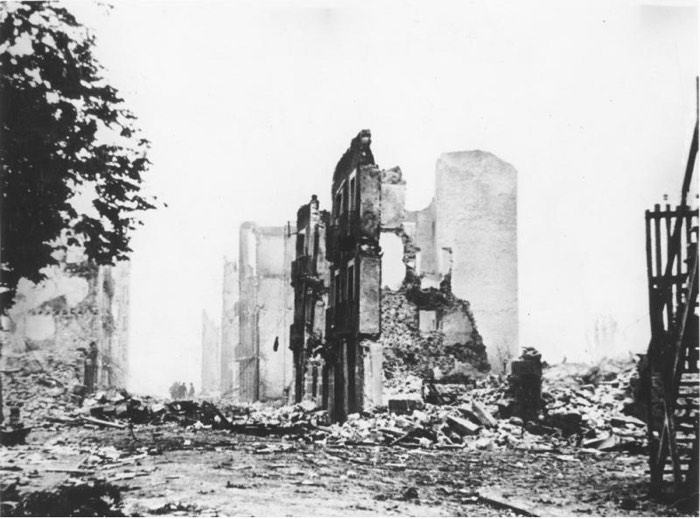
The more I looked, the more I saw the real events unfold in my head. I couldn’t separate the painting from the destruction and loss of life from the bombing. I saw the ash-covered woman from Allepo. I saw the World Trade Centers fall. And I ached for our pain-filled world.
What made the whole experience even worse was looking at the exhibition of Picasso’s sketches and plans for the painting.

The horror in this drawing alone won’t leave my head and will haunt me for years to come.
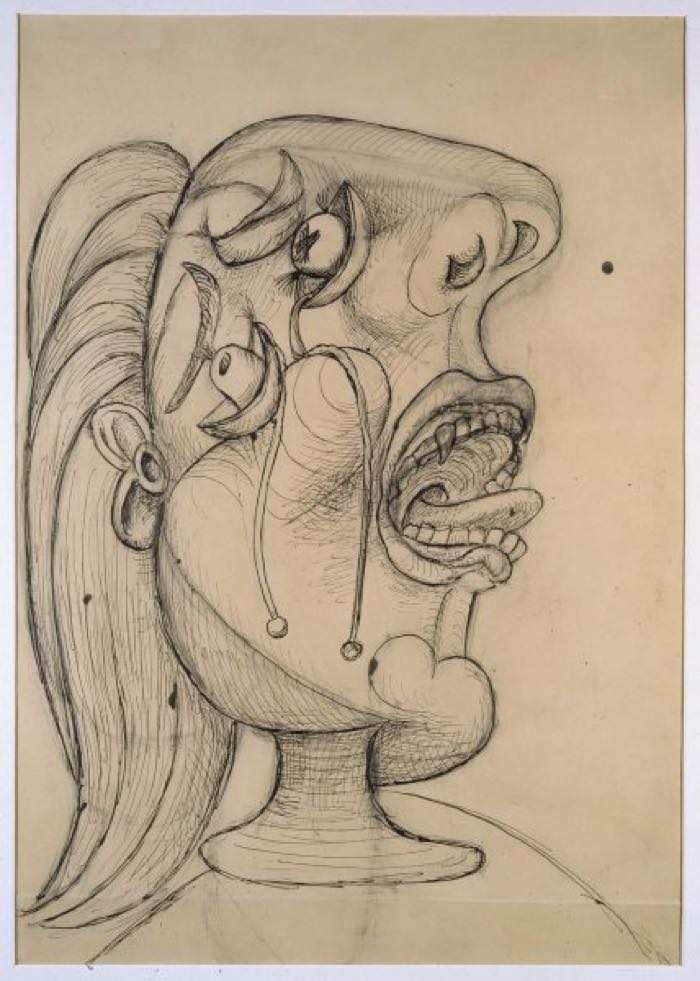
In the museum, there was a series of photographs that showed the progression of the painting. It was fascinating to me to see how Picasso added and subtracted imagery. Early in the progression, there seemed to be larger and more obvious symbols of hope. The man who in the final painting is sliced in half was made whole with his arm and fist shooting up in protest. These signs of strength and hope were dismantled and fractured to where they ended up almost gone.

What also struck me about the painting is how connected to the artist I felt. Picasso’s paintings to me usually are so perfect and precise. Even though they depict fractured faces and distorted figures, the colors are bold and solid and the lines clean. This painting lived and breathed in its imperfection. You could see the underpainting of previous drafts show through, and the paint drips and spatters added to the emotion of the piece.
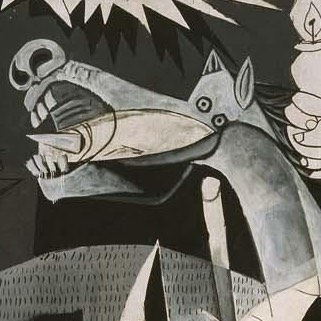
I left the museum unable to look at any other art, because I felt vulnerable and full and like I had witnessed a terrible event. As predicted, I did cry in front of the painting, but the cry was an unexpected and stifled sob rather than the “moved to tears” happy cry that I expected.
The experience reminded me of Kant’s idea of The Sublime (which I’ve written about in the past). The sublime can be described as “a greatness beyond all possibility of calculation, measurement, or imitation.” That’s what this artwork was for me. It was sublime in its effectiveness and its subject matter. It’s a terrible and wonderful painting and a paradox of an experience that is hard to describe but one that I will hold with me forever in wonder.
Teaching Guernica
Last semester, my 7th graders and I spent a couple days unpacking this painting. Here are some learning activities you could use to introduce this artwork.
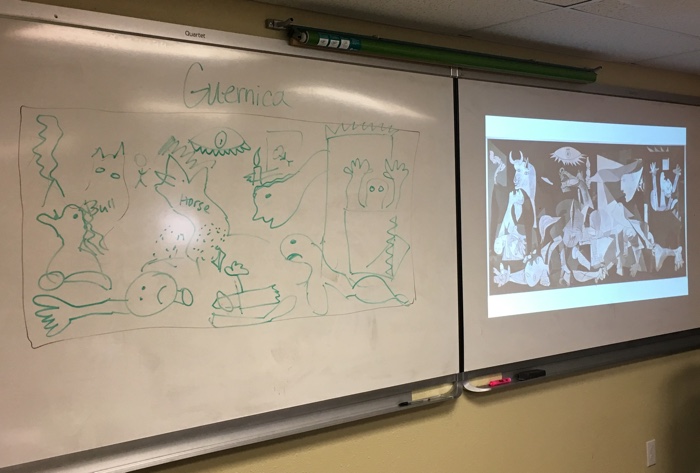
- Memorization Drawing — I displayed Guernica on the screen and invited my students to study it for many minutes. I told them to memorize every aspect of it. I then traced the outline of the painting on the whiteboard (the whiteboard doubles as my projector space) and then turned off the projector. I asked students to tell me what they remembered about the painting as I drew in what they described. You could also have them work in groups to recreate the painting or have them write what they remember.
- Drawing — Study Picasso’s sketches, and then have students practice drawings that communicate different emotions.
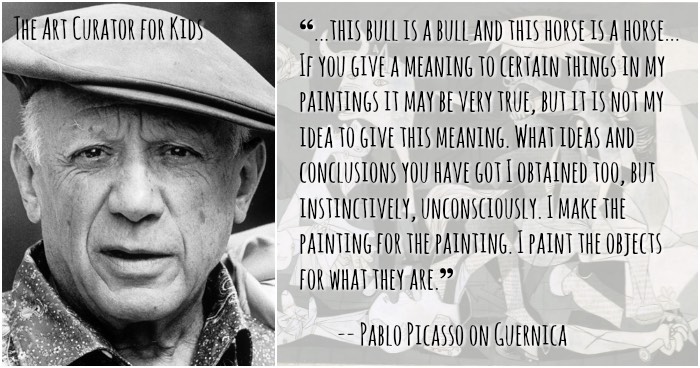
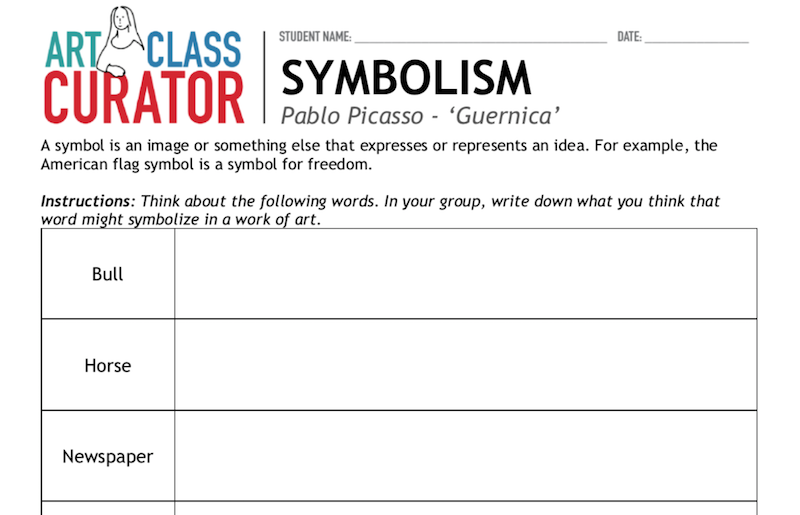
Download this free worksheet to prepare your students for the painting and its symbols. Picasso said that any symbols did not come from him, but it’s undeniable that symbolism exists in the painting. Have students consider what each element of the painting represents before leading any discussions or activities in this artwork.

Free Worksheet!
Symbolism in Guernica Worksheet
Use this free worksheet to help your students reflect on ‘Guernica’ and its symbols.






Love your Picasso ideas – can’t wait to read more of your stuff .
Thank you! 🙂
This is a great read!
Thank you! 🙂
Your lesson is so timely with all the tragic events still occurring in Syria. I have been out of the teaching profession for some time, but used to teach about the Holocaust. I think history teachers would find this art lesson to be something they could implement in their classroom. When I taught the Holocaust, it seemed so imaginable to my students, yet the atrocities being committed in Rwanda came to light and they were horrific at the time. And, then came 911… Sadly, our youth can now relate the horrors witnessed by Picasso to the horrors being experienced in Syria today, as well as the senseless terrorist acts of bombing the innocent watching a race or catching the morning train, or the insane act of driving a truck into a defenseless crowd. Another book that I love that would connect to this lesson is Eric Carle’s “The Artist Who Painted a Blue Horse”. And the possibilities for English and Literature teachers are endless!!! What a powerful cross-curricular lesson you’ve created!
Thank you for your profound thoughts. Yes, Syria was so very close on my mind when looking at this painting. It is amazing and devestating how timeless art is.
HELLO,
ITS WAY TO DESCRIBE AN ART WORK IS SIMPLY LIKE MY. I LIKE TO COUNT MY CULTURAL EXPERIENCES FOR MY STUDENTS AND THAT HAS BRINGS GOOD RESULTS, I LOVE WHEN THEY COME AND SAY; PROFESSOR VI AN ART WORK OR I SAW A POSTER OF AN EXHIBITION AND I REMEMBERED YOU. BIOGRAPHY, YOUR WORK CINDY, PARABENS!
What resource(s) did you use for teaching drawing that communicates different emotions? I can’t wait to begin this unit with my students! Thank you.
Hi
I love your lesson
Did your students paint or draw their own?
If so, do you have pictures and or what did you ask them to do?
Thanks
tracy
I teach a Guernica lesson to 2nd grade. When asked why he painted this story, the kids tell me, “So we remember what happened”. In turn, they talk about and draw their own memories, be it when their sibling was born, fishing with grandpa, loosing a pet, or even tragic events they’ve experienced, It’s always incredibly moving